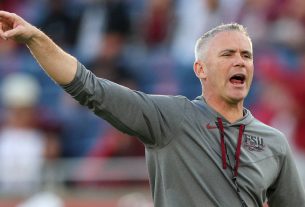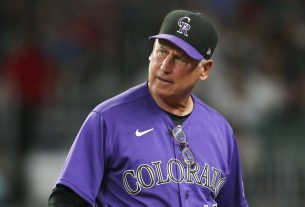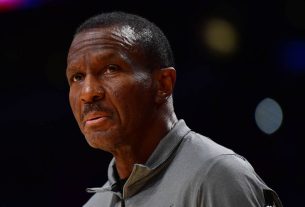[ad_1]
The Padres and right-hander Yu Darvish are in agreement on a six-year extension that’ll run through the 2028 season, AJ Cassavell and Mark Feinsand of MLB.com report (Twitter link). Darvish, a Wasserman client, was already under contract for $18M in 2023. That means the deal will tack on five years and $90M worth of new money to his contract, which will carry through Darvish’s age-41 season.
It’s a remarkable contract considering Darvish’s age, although at an average annual value of $18M, he hardly needs to perform like an ace in order to continue to justify the price tag. That’s the same AAV the Phillies committed to Taijuan Walker this offseason, for instance, and over the life of the new contract, the AAV for high-end pitching only figures to continue to increase. That said, any long-term deal running through a pitcher’s age-41 season — Darvish will turn 42 about six weeks before the contract ends — is obviously teeming with risk.
As things currently stand, however, Darvish remains among the game’s best starters. The right-hander’s age-35 campaign saw him pile up 194 2/3 innings of 3.10 ERA ball with strikeout and walk rates (25.6% and 4.8%) that were far better than league average (particularly the walk rate). Darvish’s 95 mph average fastball was actually the second-best mark of his career, and those 194 2/3 frames were the second-highest single-season total he’s logged since signing with the Rangers back in 2012.
Darvish had Tommy John surgery back in March 2015, missing the entirety of that season and a substantial chunk of the 2016 campaign while recovering. His 2018 season with the Cubs, who originally signed him to the six-year, $126M deal on which he’d previously been playing, was limited to just 40 innings thanks to a triceps injury. Since that time, however, Darvish has been quite durable. He made all 12 of his starts during the shortened 2020 season, and in each of his past three 162-game seasons, he’s taken the hill at least 30 times.
The Padres had been set to lose both Darvish and Blake Snell to free agency following the 2023 season, with both heading into the final seasons of their respective contracts. Darvish, however, now looks likely to not only remain in San Diego, but finish out his career as a member of the Padres under president of baseball operations A.J. Preller, who played a major role in signing Darvish when he was in the Rangers front office. Darvish joins San Diego native Joe Musgrove, who inked a five-year extension last summer, as the bedrock of the Padres rotation for the foreseeable future.
Keeping Darvish under contract is of particular benefit with the final two spots on the starting staff already going to relievers who’ll be making the shift to full-time starters in 2023: Nick Martinez and Seth Lugo. Both players have player options on their contracts for 2024, meaning if things go smoothly they’ll likely opt out of the contracts and test free agency on the heels of improved platform seasons. If the shift to starting roles doesn’t work out, then the Padres will obviously be seeking alternative options, be they in-house or external acquisitions. Either way, prior to the Darvish extension it was possible — if not downright likely — that San Diego would’ve entered the 2023-24 offseason in search of as many as four starting pitchers. That’s no longer the case.
Darvish carries extra importance from a long-term vantage point when considering the Padres’ dealings in recent years. Preller is among the sport’s most aggressive executives on the trade market, and with the Friars in an all-out, win-at-all-costs blitz, they’ve shown little concern with dismantling their once-vaunted farm system as a means of bringing in major league talent. Trades of names like MacKenzie Gore, Chris Paddack, Cal Quantrill and Luis Patino have depleted the organization’s pitching pipeline, while the general attrition (injuries and/or poor performances) from the remaining prospects like Ryan Weathers, Adrian Morejon and Pedro Avila leave the system without much immediate help on the horizon.
Beyond the sheer need for long-term help in the rotation, there’s surely an element of financial creativity at play here. Darvish’s pre-existing six-year, $126M contract came with a $21M luxury hit (based on the contract’s AAV). Since this new deal is being tacked on to the end of that old contract, it effectively becomes an 11-year, $216M deal. That comes with a reduced luxury hit of $19.64M. It’s not a major savings, but the Padres were right up against the third tier of luxury penalization, so any newly created breathing room is quite welcome. Once crossing into that third luxury tier, a team is penalized not only in the form of steeper tax rates, but also by having its top pick in the next year’s draft dropped by 10 places.
The Darvish extension puts some distance between the team and that particularly undesirable slap on the wrist. It also makes things slightly easier for Preller and his staff if they hope to remain under that tax level but still want to create some wiggle room for in-season acquisitions on the trade market.
If the $273M tax barrier remains a hard stopping point for the Padres once the season’s underway, that’ll likely require the Padres to convince a trade partner to include some money or take on a contract in return. Nonetheless, this extra bit of space could prove useful in accommodating more complementary additions like bullpen help or added bench depth. Alternatively, it could provide necessary space to eventually select the contract of a non-roster veteran with a salary of modest note — someone like reliever Craig Stammen or catcher Pedro Severino, for instance.
As we saw with the Padres’ 11-year signing of Xander Bogaerts — and their reported overtures toward Aaron Judge and Trea Turner — the team is clearly comfortable paying a player into his early 40s if it means lowering the overall luxury bill. All of those offers, Bogaerts and Darvish included, featured annual rates comfortably shy of where the players might have otherwise landed on a more conventional structure. Darvish’s newly added $90M in guarantees, for instance, could perhaps have been obtained over a three- or certainly a four-year deal had he opted to play out the final season of his contract and return to free agency. Instead, he’ll effectively take three- or four-year money and spread it out over a five-year extension of his contract in order to remain with a contending team and a setting where he’s clearly comfortable.
Those benefits, in the end, are generally secondary. The Padres clearly had a desire to extend Darvish and likely agreed upon the requisite dollars before determining the length of the contract and, thereby, the extent to which they could tamp down their tax bill. The end result is that Darvish and Musgrove will continue to form a formidable one-two punch in the years to come. And while paying Darvish $18M in his age-40 and age-41 seasons might prove an untenable outcome, it also perhaps creates some present-day savings in terms of luxury taxes that will make those final years a bit easier to stomach.
[ad_2]
Source link



